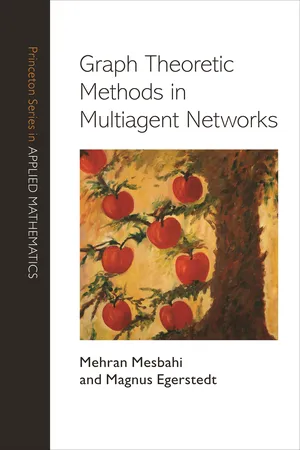
- 424 pages
- English
- ePUB (mobile friendly)
- Available on iOS & Android
Graph Theoretic Methods in Multiagent Networks
About this book
This accessible book provides an introduction to the analysis and design of dynamic multiagent networks. Such networks are of great interest in a wide range of areas in science and engineering, including: mobile sensor networks, distributed robotics such as formation flying and swarming, quantum networks, networked economics, biological synchronization, and social networks. Focusing on graph theoretic methods for the analysis and synthesis of dynamic multiagent networks, the book presents a powerful new formalism and set of tools for networked systems.
The book's three sections look at foundations, multiagent networks, and networks as systems. The authors give an overview of important ideas from graph theory, followed by a detailed account of the agreement protocol and its various extensions, including the behavior of the protocol over undirected, directed, switching, and random networks. They cover topics such as formation control, coverage, distributed estimation, social networks, and games over networks. And they explore intriguing aspects of viewing networks as systems, by making these networks amenable to control-theoretic analysis and automatic synthesis, by monitoring their dynamic evolution, and by examining higher-order interaction models in terms of simplicial complexes and their applications.
The book will interest graduate students working in systems and control, as well as in computer science and robotics. It will be a standard reference for researchers seeking a self-contained account of system-theoretic aspects of multiagent networks and their wide-ranging applications.
This book has been adopted as a textbook at the following universities:
?
- University of Stuttgart, Germany
- Royal Institute of Technology, Sweden
- Johannes Kepler University, Austria
- Georgia Tech, USA
- University of Washington, USA
- Ohio University, USA
Frequently asked questions
- Essential is ideal for learners and professionals who enjoy exploring a wide range of subjects. Access the Essential Library with 800,000+ trusted titles and best-sellers across business, personal growth, and the humanities. Includes unlimited reading time and Standard Read Aloud voice.
- Complete: Perfect for advanced learners and researchers needing full, unrestricted access. Unlock 1.4M+ books across hundreds of subjects, including academic and specialized titles. The Complete Plan also includes advanced features like Premium Read Aloud and Research Assistant.
Please note we cannot support devices running on iOS 13 and Android 7 or earlier. Learn more about using the app.
Information
PART 1
FOUNDATIONS
Chapter One
Introduction
let him set down only what he knows.
I have guesses enough of my own.” — Goethe
1.1 HELLO, NETWORKED WORLD
1.2 MULTIAGENT SYSTEMS
1.2.1 Boids Model
Table of contents
- Cover
- Title Page
- Copyright
- Dedication
- Contents
- Preface
- Notation
- Part 1 - Foundations
- Part 2 - Multiagent Networks
- Part 3 - Networks As Systems
- Bibliography
- Index